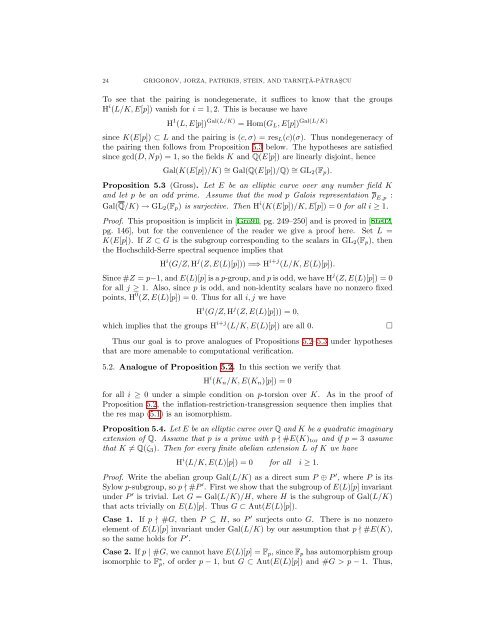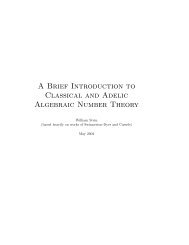COMPUTATIONAL VERIFICATION OF THE BIRCH ... - William Stein
COMPUTATIONAL VERIFICATION OF THE BIRCH ... - William Stein
COMPUTATIONAL VERIFICATION OF THE BIRCH ... - William Stein
You also want an ePaper? Increase the reach of your titles
YUMPU automatically turns print PDFs into web optimized ePapers that Google loves.
24 GRIGOROV, JORZA, PATRIKIS, STEIN, AND TARNIT¸ Ǎ-PǍTRAS¸CU<br />
To see that the pairing is nondegenerate, it suffices to know that the groups<br />
H i (L/K, E[p]) vanish for i = 1, 2. This is because we have<br />
H 1 (L, E[p]) Gal(L/K) = Hom(GL, E[p]) Gal(L/K)<br />
since K(E[p]) ⊂ L and the pairing is (c, σ) = resL(c)(σ). Thus nondegeneracy of<br />
the pairing then follows from Proposition 5.3 below. The hypotheses are satisfied<br />
since gcd(D, Np) = 1, so the fields K and Q(E[p]) are linearly disjoint, hence<br />
Gal(K(E[p])/K) ∼ = Gal(Q(E[p])/Q) ∼ = GL2(Fp).<br />
Proposition 5.3 (Gross). Let E be an elliptic curve over any number field K<br />
and let p be an odd prime. Assume that the mod p Galois representation ρ E,p :<br />
Gal(Q/K) → GL2(Fp) is surjective. Then H i (K(E[p])/K, E[p]) = 0 for all i ≥ 1.<br />
Proof. This proposition is implicit in [Gro91, pg. 249–250] and is proved in [Ste02,<br />
pg. 146], but for the convenience of the reader we give a proof here. Set L =<br />
K(E[p]). If Z ⊂ G is the subgroup corresponding to the scalars in GL2(Fp), then<br />
the Hochschild-Serre spectral sequence implies that<br />
H i (G/Z, H j (Z, E(L)[p])) =⇒ H i+j (L/K, E(L)[p]).<br />
Since #Z = p−1, and E(L)[p] is a p-group, and p is odd, we have H j (Z, E(L)[p]) = 0<br />
for all j ≥ 1. Also, since p is odd, and non-identity scalars have no nonzero fixed<br />
points, H 0 (Z, E(L)[p]) = 0. Thus for all i, j we have<br />
H i (G/Z, H j (Z, E(L)[p])) = 0,<br />
which implies that the groups H i+j (L/K, E(L)[p]) are all 0. <br />
Thus our goal is to prove analogues of Propositions 5.2–5.3 under hypotheses<br />
that are more amenable to computational verification.<br />
5.2. Analogue of Proposition 5.2. In this section we verify that<br />
H i (Kn/K, E(Kn)[p]) = 0<br />
for all i ≥ 0 under a simple condition on p-torsion over K. As in the proof of<br />
Proposition 5.2, the inflation-restriction-transgression sequence then implies that<br />
the res map (5.1) is an isomorphism.<br />
Proposition 5.4. Let E be an elliptic curve over Q and K be a quadratic imaginary<br />
extension of Q. Assume that p is a prime with p ∤ #E(K)tor and if p = 3 assume<br />
that K = Q(ζ3). Then for every finite abelian extension L of K we have<br />
H i (L/K, E(L)[p]) = 0 for all i ≥ 1.<br />
Proof. Write the abelian group Gal(L/K) as a direct sum P ⊕ P ′ , where P is its<br />
Sylow p-subgroup, so p ∤ #P ′ . First we show that the subgroup of E(L)[p] invariant<br />
under P ′ is trivial. Let G = Gal(L/K)/H, where H is the subgroup of Gal(L/K)<br />
that acts trivially on E(L)[p]. Thus G ⊂ Aut(E(L)[p]).<br />
Case 1. If p ∤ #G, then P ⊆ H, so P ′ surjects onto G. There is no nonzero<br />
element of E(L)[p] invariant under Gal(L/K) by our assumption that p ∤ #E(K),<br />
so the same holds for P ′ .<br />
Case 2. If p | #G, we cannot have E(L)[p] = Fp, since Fp has automorphism group<br />
isomorphic to F ∗ p, of order p − 1, but G ⊂ Aut(E(L)[p]) and #G > p − 1. Thus,
















